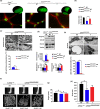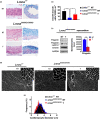Interleukin-6 neutralization ameliorates symptoms in prematurely aged mice
- PMID: 33393189
- PMCID: PMC7811841
- DOI: 10.1111/acel.13285
Interleukin-6 neutralization ameliorates symptoms in prematurely aged mice
Abstract
Hutchinson-Gilford progeria syndrome (HGPS) causes premature aging in children, with adipose tissue, skin and bone deterioration, and cardiovascular impairment. In HGPS cells and mouse models, high levels of interleukin-6, an inflammatory cytokine linked to aging processes, have been detected. Here, we show that inhibition of interleukin-6 activity by tocilizumab, a neutralizing antibody raised against interleukin-6 receptors, counteracts progeroid features in both HGPS fibroblasts and LmnaG609G/G609G progeroid mice. Tocilizumab treatment limits the accumulation of progerin, the toxic protein produced in HGPS cells, rescues nuclear envelope and chromatin abnormalities, and attenuates the hyperactivated DNA damage response. In vivo administration of tocilizumab reduces aortic lesions and adipose tissue dystrophy, delays the onset of lipodystrophy and kyphosis, avoids motor impairment, and preserves a good quality of life in progeroid mice. This work identifies tocilizumab as a valuable tool in HGPS therapy and, speculatively, in the treatment of a variety of aging-related disorders.
Keywords: accelerated aging; ageing; anti-aging; cellular senescence; cytokines; inflammation; laminopathies; nuclear lamina.
© 2021 The Authors. Aging Cell published by the Anatomical Society and John Wiley & Sons Ltd.
Conflict of interest statement
None declared.
Figures






Similar articles
-
Vascular Smooth Muscle-Specific Progerin Expression Accelerates Atherosclerosis and Death in a Mouse Model of Hutchinson-Gilford Progeria Syndrome.Circulation. 2018 Jul 17;138(3):266-282. doi: 10.1161/CIRCULATIONAHA.117.030856. Epub 2018 Feb 28. Circulation. 2018. PMID: 29490993 Free PMC article.
-
Ghrelin delays premature aging in Hutchinson-Gilford progeria syndrome.Aging Cell. 2023 Dec;22(12):e13983. doi: 10.1111/acel.13983. Epub 2023 Oct 19. Aging Cell. 2023. PMID: 37858983 Free PMC article.
-
Targeting CRM1 for Progeria Syndrome Therapy.Aging Cell. 2025 May;24(5):e14495. doi: 10.1111/acel.14495. Epub 2025 Jan 27. Aging Cell. 2025. PMID: 39871520 Free PMC article.
-
Towards delineating the chain of events that cause premature senescence in the accelerated aging syndrome Hutchinson-Gilford progeria (HGPS).Biochem Soc Trans. 2020 Jun 30;48(3):981-991. doi: 10.1042/BST20190882. Biochem Soc Trans. 2020. PMID: 32539085 Free PMC article. Review.
-
Epigenetic involvement in Hutchinson-Gilford progeria syndrome: a mini-review.Gerontology. 2014;60(3):197-203. doi: 10.1159/000357206. Epub 2014 Feb 28. Gerontology. 2014. PMID: 24603298 Review.
Cited by
-
Pro-inflammatory cytokines as emerging molecular determinants in cardiolaminopathies.J Cell Mol Med. 2021 Dec;25(23):10902-10915. doi: 10.1111/jcmm.16975. Epub 2021 Nov 12. J Cell Mol Med. 2021. PMID: 34773379 Free PMC article.
-
Aging research from bench to bedside and beyond: What we learned from Sammy Basso.Aging Cell. 2024 Dec;23(12):e14414. doi: 10.1111/acel.14414. Aging Cell. 2024. PMID: 39663551 Free PMC article. No abstract available.
-
Impact of Progerin Expression on Adipogenesis in Hutchinson-Gilford Progeria Skin-Derived Precursor Cells.Cells. 2021 Jun 25;10(7):1598. doi: 10.3390/cells10071598. Cells. 2021. PMID: 34202258 Free PMC article.
-
STAT1 Drives the Interferon-Like Response and Aging Hallmarks in Progeria.Aging Biol. 2023;1:20230009. doi: 10.59368/agingbio.20230009. Epub 2023 Jun 28. Aging Biol. 2023. PMID: 40255266 Free PMC article.
-
Impact of miR-181a on SIRT1 Expression and Senescence in Hutchinson-Gilford Progeria Syndrome.Diseases. 2025 Aug 4;13(8):245. doi: 10.3390/diseases13080245. Diseases. 2025. PMID: 40863219 Free PMC article.
References
-
- Aguado, J. , Sola‐Carvajal, A. , Cancila, V. , Revêchon, G. , Ong, P. F. , Jones‐Weinert, C. W. , Wallén Arzt, E. , Lattanzi, G. , Dreesen, O. , Tripodo, C. , Rossiello, F. , Eriksson, M. , & d'Adda di Fagagna, F. (2019). Inhibition of DNA damage response at telomeres improves the detrimental phenotypes of Hutchinson‐Gilford Progeria Syndrome. Nature Communications, 10(1), 4990 10.1038/s41467-019-13018-3 - DOI - PMC - PubMed
-
- Antoniel, M. , Traina, F. , Merlini, L. , Andrenacci, D. , Tigani, D. , Santi, S. , Cenni, V. , Sabatelli, P. , Faldini, C. , & Squarzoni, S. (2020). Tendon extracellular matrix remodeling and defective cell polarization in the presence of collagen VI mutations. Cells, 9(2), 409 10.3390/cells9020409 - DOI - PMC - PubMed
-
- Avnet, S. , Pallotta, R. , Perut, F. , Baldini, N. , Pittis, M. G. , Saponari, A. , Lucarelli, E. , Dozza, B. , Greggi, T. , Maraldi, N. M. , Capanni, C. , Mattioli, E. , Columbaro, M. , & Lattanzi, G. (2011). Osteoblasts from a mandibuloacral dysplasia patient induce human blood precursors to differentiate into active osteoclasts. Biochimica Et Biophysica Acta, 1812(7), 711–718. 10.1016/j.bbadis.2011.03.006 - DOI - PubMed
-
- Baran, P. , Hansen, S. , Waetzig, G. H. , Akbarzadeh, M. , Lamertz, L. , Huber, H. J. , Ahmadian, M. R. , Moll, J. M. , & Scheller, J. (2018). The balance of interleukin (IL)‐6, IL‐6.soluble IL‐6 receptor (sIL‐6R), and IL‐6.sIL‐6R.sgp130 complexes allows simultaneous classic and trans‐signaling. Journal of Biological Chemistry, 293(18), 6762–6775. 10.1074/jbc.RA117.001163 - DOI - PMC - PubMed
Publication types
MeSH terms
Substances
LinkOut - more resources
Full Text Sources
Other Literature Sources
Molecular Biology Databases
Miscellaneous

